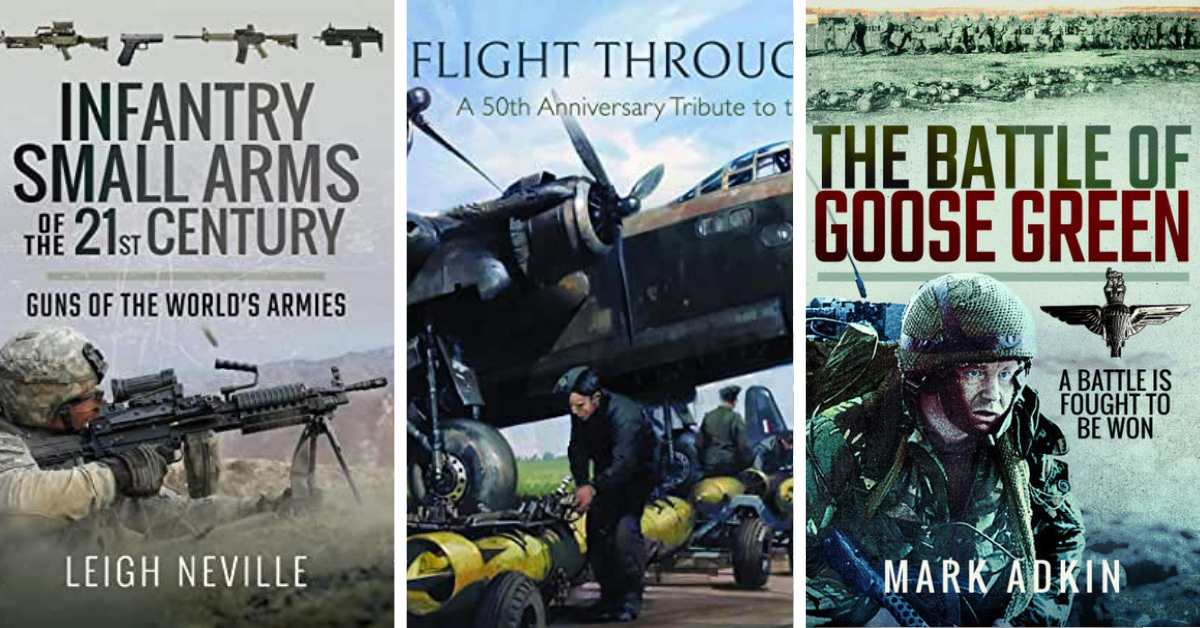As we edge closer to the fortieth anniversary, it’s a little surprising that the Falklands War continues to excite a fair degree of commentary and debate after all this time. Social media helps this, of course; treating us to a ripe old mix of injured pride, Anglophobia and not a little flag waving.
I was 23 years old on the day British forces landed to retake the islands, and like a great many people I listened intently to news updates and poured over the London evening newspapers on my way home from work. Once the war had ended it did not take long for the first pieces of literature to appear in the form of books, magazine articles and part-works.
I have my favourites and one of them, The Green Eyed Boys bears some similarities to this excellent book by Mark Adkin, a former soldier with a number of books to his credit.
The author treats us to an old fashioned straight up history book by setting the context, explaining the planning and preparations by both sides and examining the opposing forces. He goes on to tell the story of the battle itself using both the British and Argentinian perspectives. Mr Adkin was a soldier, so he knows about detail. Most importantly he understands the dynamics of the plan and subsequent reality of the attack led by Colonel ‘H’ Jones of 2 Para.
The Falklands gave us one of the last proper old-time wars. There were no surveillance drones or the trickery available to armies today. Much of the weaponry and equipment on view would have offered no mystery to the men who fought World War II. The fighting was a slog in horrible weather on an inhospitable landscape.
The defenders have sometimes been billed as innocent conscripts abandoned by their officers while the invading force were the foot soldiers of an anachronistic remnant from the colonial age. Even Newsweek gave us a memorable edition with the headline The Empire Strikes Back.
The truth is much more nuanced. The defenders were far from outnumbered by the opposition and although many of the troops were inexperienced, there was a strong spine of tough NCOs. The British suffered huge logistical problems, lacking helicopters and enough artillery.
We learn from Mr Adkin that the British senior officer leading the invasion was forever being overruled and micromanaged from London by people who did not grasp the problems he faced. Brigadier Julian Thompson of the Royal Marines must have been immensely frustrated by this nonsense, but he got on with it and set out to reclaim the islands for Britain.
Mr Adkin gives us a blow by blow account of the Battle of Goose Green. The story remains inextricably linked to the death in action of the commander of 2 Para, Colonel “H” Jones, an aggressive no nonsense go-getter who was killed leading from the front.
He was awarded a posthumous Victoria Cross. The important thing is to not get bogged down in Jones’ death. It came at a time when victory was far off and there was a lot of fighting to do. The battle was a classic battalion strength affair with the addition of supporting arms.
The British warship sent to lend fire support had to duck out quickly with a faulty gun. This left the artillery to take things on. The paratroopers themselves – the Toms – were left with a serious challenge, but they got the job done after taking a fair number of losses. The Argentinians fought until it was plain there was no hope of victory.
The battle takes its twists and turns, and Mr Adkin lays it all out in good style. His book was first published in 1992 and this reissue is most welcome. This book is an honest account of an important battle in a war that recedes in memory but never loses its punch.

THE BATTLE OF GOOSE GREEN
A Battle is Fought to be Won
By Mark Adkin
Pen & Sword
ISBN: 978 1 52676 0 142
If you like your history books to be both informative and fun, look no further than this delightful read from Austin J Ruddy. Books that tell stories in the format of a hundred this or that have been around for a little while, but please don’t assume the format is a bit tired because this particular outing really works well.
The author sets out to illustrate life on the British Home Front during World War II by selecting important artefacts that underpin the story of the six years of war. He gets off to brilliant start by showing us the “If War Should Come” pamphlet that backed up the public information film of the same name which sought to assure the British public that their government was prepared for things to come. Mr Ruddy helps things along by showing the next pamphlets in the series.
We move on with a number of “obvious” items; gas masks, ration books, identity cards, petrol coupons and so on. At all times the author is able to provide a personal dimension to his selection – the identity card is his father’s.
There are other interesting things – bits of bomb casing and anti-aircraft shell fragments. Lumps of coal, booklets, posters, money, uniforms, tin hats and much, much more make up the century of delights. The author looks at the good and the bad side of home front life, reminding us about the black market, looting and other serious crimes which saw some people take the long drop at Wandsworth prison. The good stuff shows that side of British phlegm – the v sign and so on – that marks a generation out.
I grew up in the aftermath of the war and so much of this book resonates with me. The author and I are on the same page.
Mr Ruddy has been a long-time collector of Home Front ephemera and he has managed to amass a fascination collage of wartime stuff. Putting it together in such a pleasing and educational way cannot have been easy, but he has smashed it and his book is a gem. Very highly recommended.
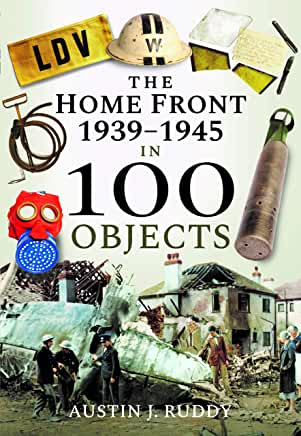
THE HOME FRONT 1939-1945 IN 100 0BJECTS
By Austin J Ruddy
Frontline
ISBN: 9 781 52674 086 1
Next up we move into one of my favourite areas – a book on aviation art. This exquisite volume celebrates the 50th anniversary of the Guild of Aviation Artists which had the great Frank Wootton in its ranks when it was founded. I bought a book of his art at the RAF Museum shop in around 1975 and I cherish it to this day.
That was followed by collecting a set of large cards of Michael Turner’s work, but they do not survive amongst my souvenirs. Happily, a number of prints I picked up in the early 1980s do. I have always loved aviation art and have my eyes on a print of a Handley Page Heyford to go in my new home sometime next year.
I digress… This is a lovely celebration of the Guild in all it’s glory. While not strictly a military book, it is, nevertheless, a joy from cover to cover. The book covers the period from the Great War to the modern era with diversions into air shows and some of the personalities of the Guild.
There are more than enough military themed paintings to delight and inspire. If you like this sort of stuff you will be in clover.
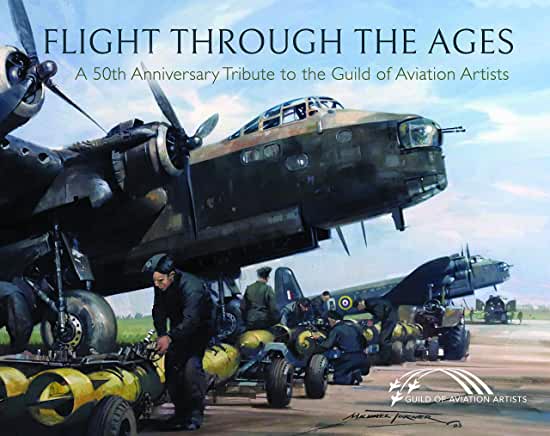
FLIGHT THROUGH THE AGES
A 50th Anniversary Tribute to the Guild of Aviation Artists
Pen & Sword Transport
ISBN: 978 1 52676 377 8
I’ve reviewed a lot of books for WHO and am fairly sure I’ve looked at previous work by Leigh Neville. This time round he provides us with a really useful guide to modern military small arms and the sheer volume of information he crams in is quite bewildering. It really is comforting to find yourself in the hands of someone who really knows their stuff.
I used to be a bit of a gun nut and have managed a little bit of shooting in my time. The ardour for it has faded a good deal, but I remain interested and books like this provide the level of knowledge and detail I really admire. I will dispense with making lists of the specifics, but you will find all the classes and types of weaponry to be expected from a book like this.
I find it quite amusing that Harry, one of my housemates, is playing Call of Duty while I’m writing this review.
Perhaps I should give it to him to check out the toys he should be playing with? Joking aside, this is a solid piece of work from Leigh Neville. I would term the book as niche, but if small arms are your thing this will be essential reading.
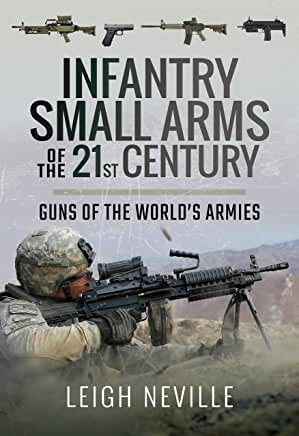
INFANTRY SMALL ARMS OF THE 21st CENTURY
Guns of the World’s Armies
By Leigh Neville
Pen & Sword Military
ISBN: 978 1 47389 613 0
We finish this dispatch with a look at another glorious warship history by Seaforth Publishing. This time round Conrad Waters looks at the British Town class cruisers that played such an important role during the Second World War and afterwards. Let us get HMS Belfast done with right away. She can be found on the River Thames in London and has been part of the city for over forty years. She is a delight. If you are in town, make sure to visit her.
Mr Waters takes us through the context of the arms limitation agreements from Washington to London that directly impacted on ship design and numbers leading up to the war. The ten Town class ships were part of that equation when the Royal Navy sought the right balance in response to new Japanese and American vessels which would give it a 6 inch gun armed cruiser capable of policing Britain’s vital trade routes to the empire and beyond.
Four of the class, Edinburgh, Gloucester, Manchester and Southampton were lost, while the others all took a battering. Their stories are generally well-known, but the author takes care to look at their war records using naval reports to outline the remedial work required by those that made it to port.
This glorious book does what it says on the tin – looking at design, development and performance of the two principle groupings within the Town class as a whole. Diagrams, original drawings and the archive photography are outstanding.
The book follows on from the recent gold rush of naval histories from this publisher. I put these books on a slow burner – browsing the snaps and working my way periodically through the serious stuff. It is a reference book, but it is also a Sunday afternoon armchair with a cup of tea experience… especially when my favourite football team is three nil down at half time and I have to turn the tv off for sanity’s sake.
This has been a fantastic year for Seaforth books and this last instalment is an absolute gem. I fully appreciate I approach it from a somewhat shallow aiming point, but I do learn stuff while loving the imagery. More serious naval buffs will be as happy with it as I am. Highly recommended.
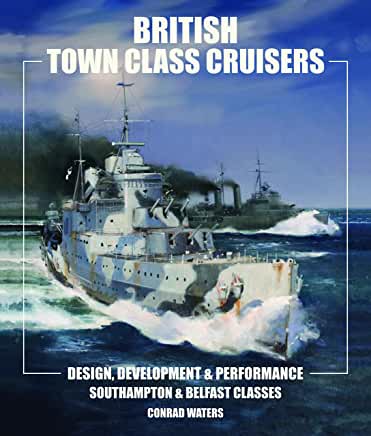
BRITISH TOWN CLASS CRUISERS
Design, Development & Performance
Southampton & Belfast Classes
By Conrad Waters
Seaforth Publishing
ISBN: 978 1 5267 1885 3
Reviewed by Mark Barnes for War History Online
